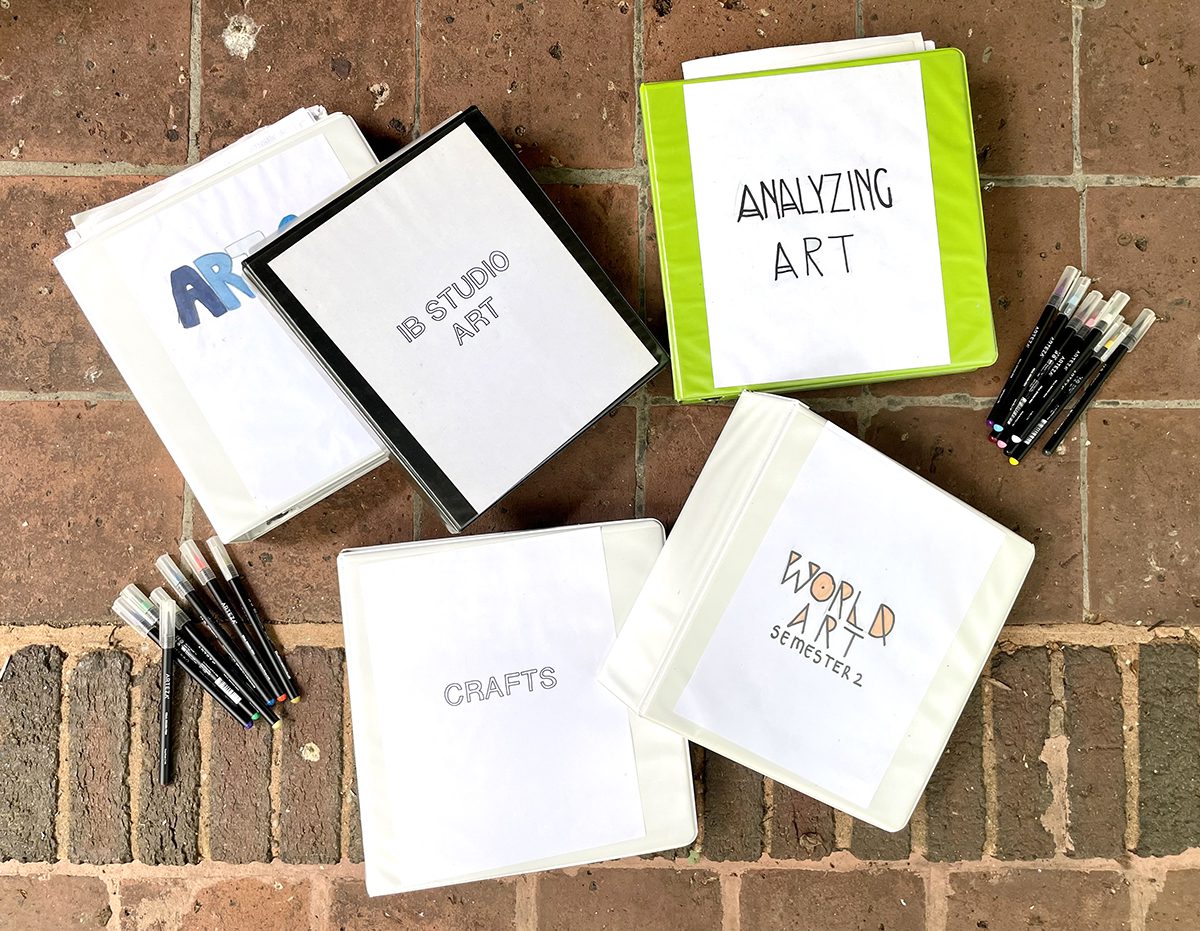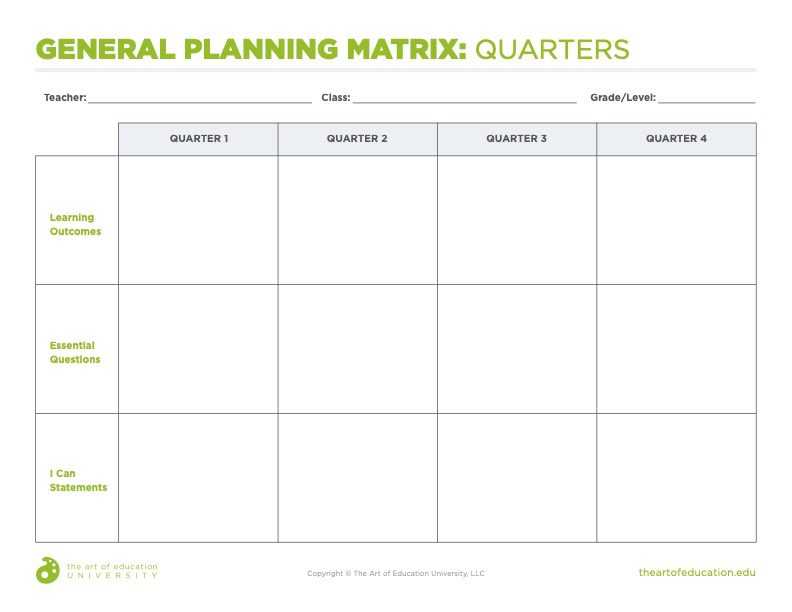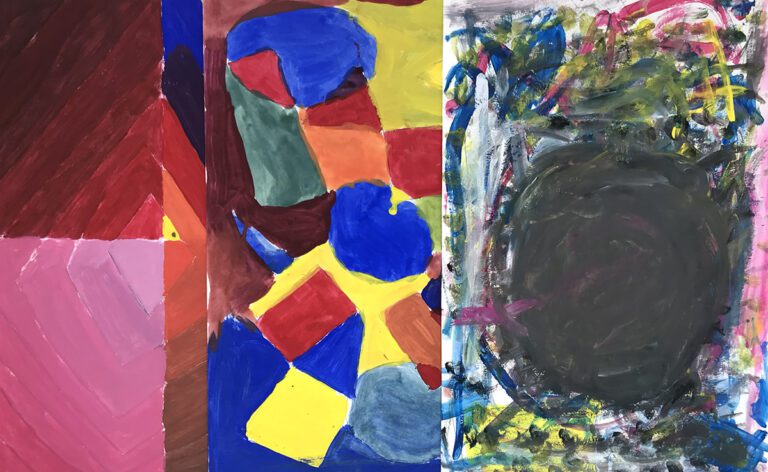Are you in the habit of scrambling each evening trying to figure out what your classes are going to do tomorrow? If planning is not your forte and the term “curriculum” makes you queasy—hold tight! We have several strategies to get you headed in the right direction. If you’re a veteran teacher and feeling confident about your curricular skills, stay with us! We encourage you to look at how you approach curriculum with a fresh perspective. After all, art teachers are always striving to learn and grow!
Today, we’ll look at the bigger picture when it comes to curriculum planning. Let’s uncover why it’s important and simple steps to get started.

Today, Megan Bellucci is joining us to share her curriculum expertise. Megan is one of AOEU’s adjunct faculty and is also a high school art teacher in New Jersey. In fact, she is the only art teacher in her school and teaches courses from Intro all the way up to AP. Because of this, Megan has hands-on experience creating well-rounded and engaging curriculums for a variety of courses.
What exactly is a curriculum? Megan succinctly describes curriculum as a framework that covers the most important elements of your course. For a more in-depth guide on the components, check out this article. Successful curriculums plan ahead yet include room for alterations once you meet your students and figure out their unique needs. As Benjamin Franklin wisely said, “By failing to prepare, you are preparing to fail.” Planning ahead of time is key to a successful year and maintaining your sanity!
For many art teachers, curriculum isn’t something we get thrilled about. Megan firmly believes it’s exciting to organize what you teach!
Here are some benefits of prioritizing curriculum in your art program:
- Provides structure to the year.
- Ensures expectations are clear.
- Sequences learning to build skills.
- Produces stronger work and artists.
- Strengthens your teaching practice.
- Promotes your art program.
Let’s take a look at seven misconceptions when it comes to designing an effective curriculum.
Misconception 1: I have to fit as many artists and mediums as possible into the curriculum.
The number one misconception art teachers tell Megan is they believe they must do everything; they must cram in every medium, art style, and artist to every course or grade level. This is the perfect time to remind us all, “You can do anything but not everything.” If you try to fit everything in, the curriculum will be surface-level and your year will feel rushed and chaotic.
Instead, start by selecting a broad theme or big idea. Then, go in and only include what naturally fits. This helps students dig into topics, scaffold and refine skills, and stay focused for the duration of the year. If it doesn’t fit, don’t include it, and don’t feel bad!
Misconception 2: I should start designing the curriculum with planning Day 1.
Initially, it makes sense to start planning at Day 1 and then make your way chronologically through the course or year. While this is one way to do it, there are more effective ways to design a curriculum. As mentioned above, start with the end in mind. Begin with an overarching theme or idea for the entire course or year and then break it down into learning outcomes, learning objectives, and/or essential questions for each quarter, month, or week, depending on how you structure your class. Working backward prevents you from getting bogged down in the details and makes for a very cohesive art show at the end!
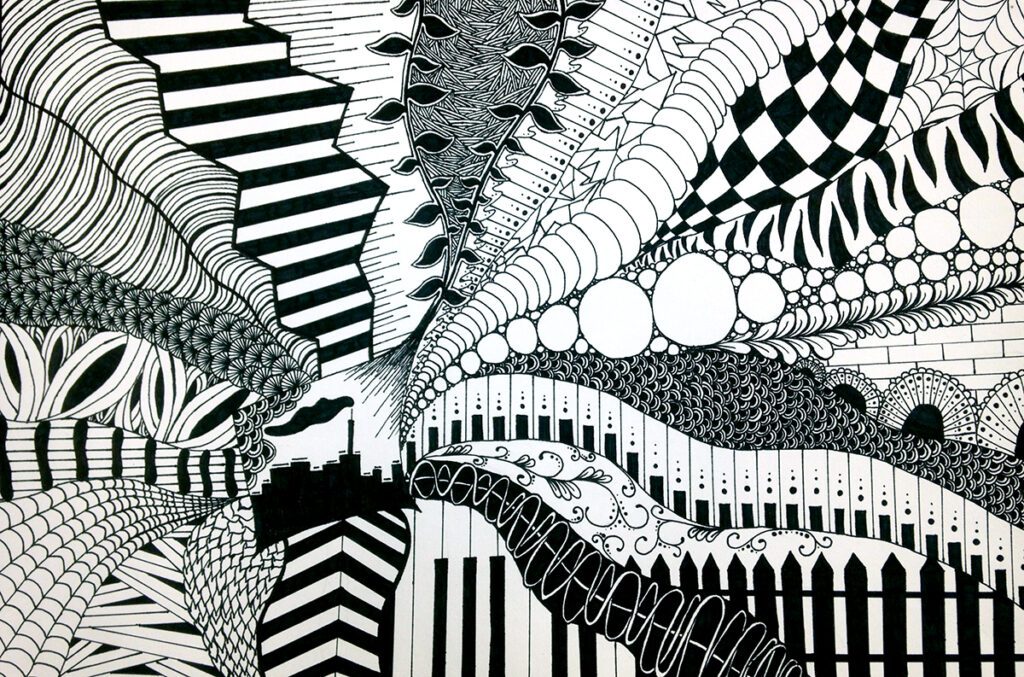
Misconception 3: I should start designing the curriculum with projects I want to incorporate.
Likewise, planning by project can be extremely time and energy intensive. Megan says when you approach curriculum with a backward design lens, the course becomes less about making “pretty things to hang on the walls” and more about concepts and skills that last. This is something all art teachers can get behind! Megan also recommends projects be the very last thing teachers plan. This allows you to swap in and out individual projects easily while keeping the overall curriculum unchanged. This is good news! Most of us get bored doing the same projects year in and year out. Having an easy way to switch out projects keeps us sharp and excited, which trickles down to the students!
Misconception 4: Aligning the curriculum to standards is extra work.
Standards can be really intimidating! Depending on your district, there can be district standards. Then, there are state standards and national standards! Sifting through them can feel like a lot of extra work that no one will likely notice.
Digging into standards is a bit more work upfront but in the long run, you’ll save time! Standards keep your curriculum on target with student levels and are a helpful starting point when planning. Even if you are not required to use standards, Megan encourages you to at least scan them to see if the curriculum is appropriate and generally on track.
Uncover more about the National Core Arts Standards with these resources:
- What Does Unpacking the National Core Arts Standards Look Like?
- Exploring the National Standards: Create (Ep. 206)
- Exploring the National Standards: Respond (Ep. 207)
- Exploring the National Standards: Connect (Ep. 208)
- Exploring the National Standards: Present (Ep. 209)
Misconception 5: I’m fine with winging the curriculum because it keeps me flexible.
One of our superpowers as art teachers is we are incredibly flexible and adaptable. Because we are creative thinkers, we’re able to ideate and implement a lesson on a whim. While this is a handy skill for when things don’t go as planned or standardized testing runs longer than anticipated, continually “winging it” can be detrimental by the end of the year. Composing the curriculum as you go increases the likelihood of unconnected projects, feeling frantic as you rush around at the last minute, and spending more money because you didn’t order smart ahead of time. Instead, plan ahead and use the margin you’ll gain to add fun elements like field trips or design challenges during the year to supplement the curriculum.

Misconception 6: I don’t need a bunch of curriculum documents—no one is going to see them so it’s not worth it anyway.
Some schools require art teachers to submit lesson plans and curriculum documents but many do not. If no one is going to see your curriculum documents, it may feel pointless to put effort into creating them! But did you know that composing clear curriculum documents can be a way to advocate for your art program? Megan recommends putting time into capturing your curriculum on paper and then cleaning it up so it’s administrator- and student-facing.
There are so many types of curriculum documents out there. It can be overwhelming to figure out which ones you need and what they’re for. Let’s take a look at the two most common ones and their purposes.
1. Action Plan or Scope and Sequence
An Action Plan or Scope and Sequence is an outline of the whole course. It provides an at-a-glance look at what skills and themes happen in what timeframe. This document is helpful for pacing and keeping your students on track.
Here is a very basic Action Plan for a specific grade level or course, broken down by month. Each month focuses on a specific concept. Pick and choose four projects to match the month’s concept in the four blank boxes on the right.
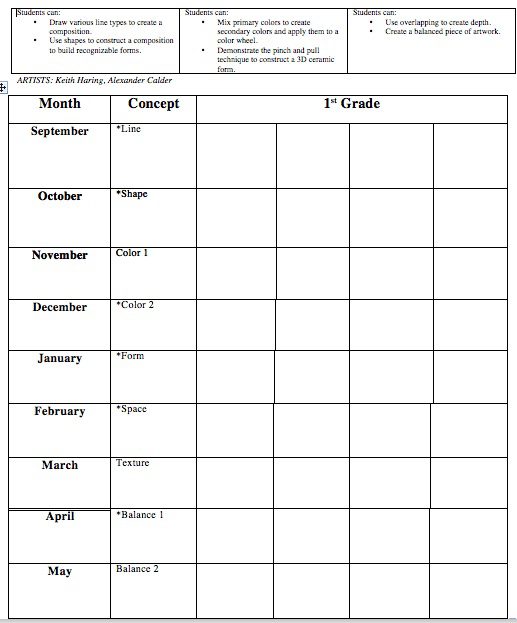
Here is a more complex Action Plan for a secondary Jewelry course. This chart includes detailed information such as standards, student learning outcomes, themes, assessments, tools, and vocabulary. As you can see, the specific projects are not included and the teacher can adjust based on student interests and needs each year.
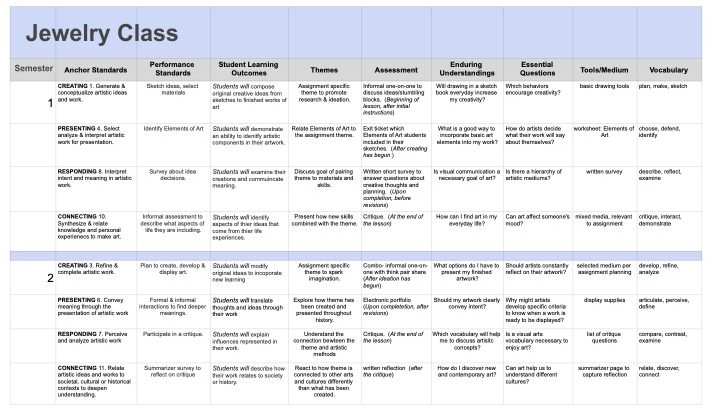
Give a copy to your students as a part of their syllabus and to parents at Back-To-School Night so they can see an overview of the year. It shows families that art is important and more than “just drawing;” it’s full of specific skills, topics, concepts, and processes! If you add a cross-curricular component, it further shows how art is valuable because it connects to other disciplines. The Action Plan can also serve as a study guide for key units at the end of the year.
If you are a FLEX Curriculum user, take a look at the available Scope and Sequences. Select from Kindergarten all the way up to High School. Each Scope and Sequence is designed around the National Core Arts Standards and offers a way to organize FLEX content throughout a school year. Check out this page for more information on how to get these Scope and Sequences for your students.
2. Curriculum Matrix or Curriculum Map
Megan compares a Curriculum Matrix or Map to the summary on the back of a book. This is less of an outline and conveys the feel of a course with specific skills and activities. It’s usually in the format of a chart or table. Let’s look at some variations!
Here is a matrix by media. If you’re looking for a way to ensure all grade levels are getting a well-rounded experience and exposure to a range of artmaking processes, this is the matrix for you. This matrix shows a project in each medium per grade level.
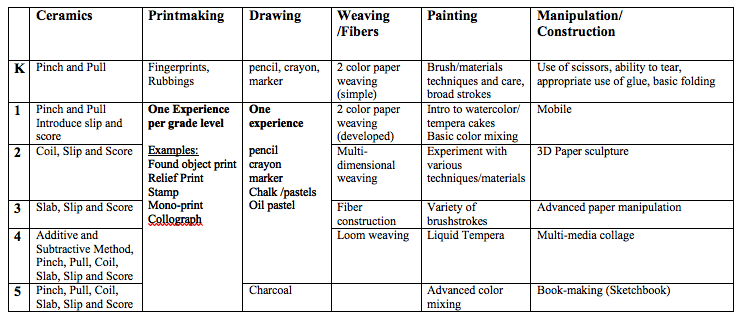
This map shows what’s happening in the first unit of an eighth grade ceramics course. It includes standards, learning outcomes, assessments, major resources, art history and cross-curricular connections, essential questions, differentiation, and vocabulary.
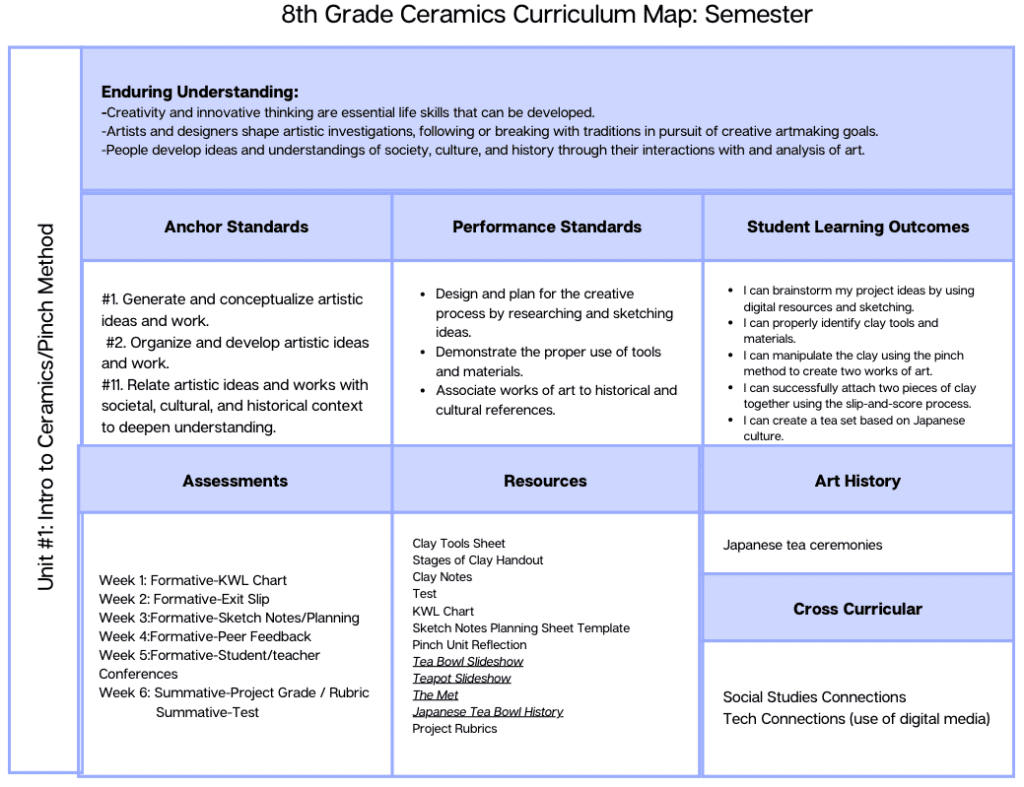
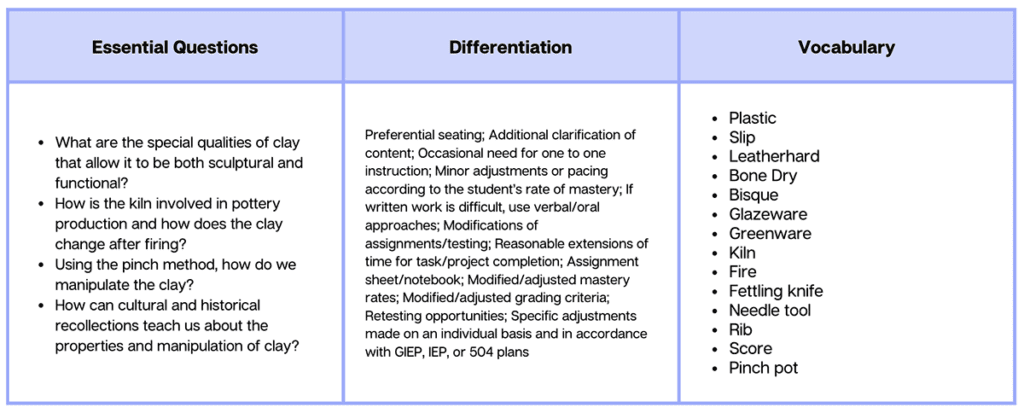
Here is a downloadable template by quarter. It covers learning outcomes, essential questions, and “I Can” statements and is a great start in the right direction. For more templates like these, enroll in Designing Your Art Curriculum.
Provide copies of your curriculum matrix to your professional school counselors to boost your course and program enrollment numbers. These maps are handy to reference when they are meeting with students and creating schedules because it provides a summary of the course.
With both of these documents, Megan reminds us not to be too specific with projects. Both are overviews or guides and not individual unit or lesson plans. This will allow you to swap projects in and out very easily, as mentioned above.
Misconception 7: I don’t need extra help with curriculum; I’ve been doing this for a long time!
The wonderful thing about art teachers is we are always learning and growing. While it may be easier to do the same thing year after year, it is not challenging to you or the students. Try new projects and approaches to maintain your passion and hone your craft. Your students are smart and will pick up on your excitement and they will appreciate you adapting to meet their specific needs.
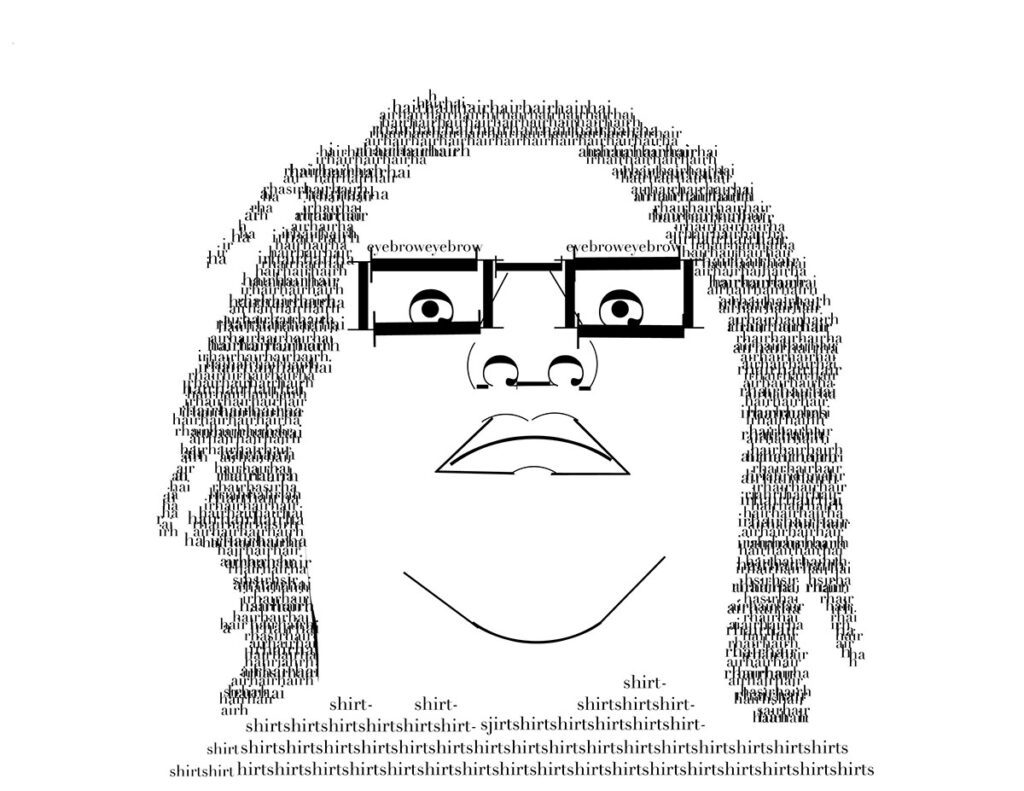
If you’re ready for a shift when it comes to curriculum but don’t know where to start, AOEU has all of your bases covered:
- Magazine and Media
Set aside 30 minutes each week to browse our archive on all things curriculum! Soak in all of our free tips and tricks to bolster your curriculum and give you more confidence with your art program. - PRO Learning
Another way to refine your curriculum planning and writing skills is to watch a PRO Pack. Learn from expert facilitators through short videos and teacher-facing resources and activities. Filter Packs by Topic and select Curriculum to dive deeper! There is a Pack on The Building Blocks of Effective Curriculum for beginners, all the way up to a Pack on Bringing New Life to Old Lessons for the veteran teacher looking to revamp. Submit this form to learn how to get the only on-demand PD designed for K-12 art teachers at your fingertips. - FLEX Curriculum
Check out FLEX Curriculum for tons of lesson plans and student-facing resources and assessments. FLEX supports backward curriculum design too! Pick your big idea and then, search by Subject, Theme, Medium, Elements & Principles, Movement, or (Content) Connection for Collections and Lessons. Browse all of FLEX’s teacher-facing guides to discover how to make the most of FLEX and see how a team of curriculum experts do it. If you’re interested in getting FLEX for your students, fill out this form. - Graduate Course
Enroll in Designing Your Art Curriculum to investigate what goes into a quality curriculum. During the course, you will plan, develop, revise, and implement curriculum you can immediately bring back to your students. To make planning easier, you will explore tons of examples and have the opportunity to customize several templates. Earn credits while organizing your curriculum at the same time! - Master’s Degree
If you are looking to refine your curriculum and bring innovative learning opportunities to your students, take a look at our new Master of Education in Curriculum and Instruction (MEd). Depending on your students’ needs and what you’d like to focus the curriculum on, specialize in one of three areas: Arts Integration, Instructional Leadership in Art Education, or Inclusive Practices for Visual Arts. Talk to an admissions counselor today to learn more.
Get in touch with an admissions counselor!
Taking the time to plan your curriculum is a must for a smooth and successful school year. Remove the intimidation by looking at curriculum as a simple outline and then start small with the steps above. There are many misconceptions when it comes to how to plan a curriculum and what makes up an effective one. Step back and begin with an overarching idea or theme to guide the process. Then, break it down into learning outcomes or objectives that align with standards to ensure everything is age-appropriate. Put in the time to make your curriculum documents professional so you can use them to promote your program with administrators, parents, and students. Remember, no matter if you’re fresh out of an art education program or a veteran with 20 years under your belt, there are exciting and innovative things to learn when it comes to curriculum! Stay relevant with one of the many resources and professional development opportunities AOEU has to offer. Happy planning!
Portions of this work are based on the National Core Arts Standards. Used with permission. National Coalition for Core Arts Standards (2015) National Core Arts Standards. Rights Administered by the State Education Agency Directors of Arts Education. Dover, DE, www.nationalartsstandards.org all rights reserved.
NCAS does not endorse or promote any goods or services offered by the Art of Education University.
What scares you most about curriculum planning?
What is the most helpful curriculum document you use?
Magazine articles and podcasts are opinions of professional education contributors and do not necessarily represent the position of the Art of Education University (AOEU) or its academic offerings. Contributors use terms in the way they are most often talked about in the scope of their educational experiences.
